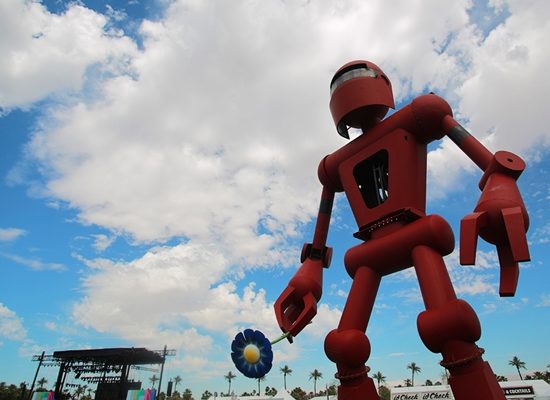The Coachella festival, a music and art event which was founded in 1999 by Paul Tollett and occurs over two consecutive weekends (“weekend one 2015” ran from April 10-12), has a history of showcasing installation art.
This past weekend, the fashion, music, and entertainment crowds descended upon Indio, California for the annual Coachella festival—expect to see pictures of many celebrities and models wearing flower crowns and suede fringed outfits flow through your news feed.
Similar to Burning Man festival in Nevada, minus the tech crowd and the “sharing is caring” mentality, conspicuous big art plays a significant part at Coachella (see Tech Nerds and Flashy Art at Burning Man).
This year there were 19 art installations on the festival grounds including a giant yellow and black caterpillar by Mike Grandaw, which overnight, turned into a blue, orange, and yellow butterfly; an enormous spacesuit, reminiscent of the MTV icon, hovering over the crowd, its arms reaching out as if to embrace them; a red robot sculpture by Christian Ristow holding a blue flower; as well as a curvaceous light installation by Stereo-Bot. Twin brothers and designers Nicolai and Simon Haas‘s “Party God,” a giant marble statue that looked like a walrus in sunglasses carrying a drink, was inspired by Bacchus, the Roman deity of ritual debauchery.
But with its star-studded lineup including Drake, Jack White, and ACDC, and its throng of celebrity attendees, it’s no wonder Coachella’s art installations, and sometimes its music, take a back seat. In 2013, Jimmy Kimmel interviewed festival-goers in a hilarious two-and-half-minute clip about bands that don’t exist, where one guy thought the fake band “Obesity Epidemic” was an “innovative and new” band.
We’re guessing what attracts a lot of people to Coachella is not so much the performances and art installations, but the parties, which, much like Art Basel in Miami Beach, are guaranteed to deliver celebrity cameos (see Art Basel in Miami Beach in Pictures From Miley Cyrus to Baz Luhrmann).
